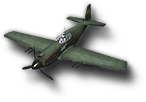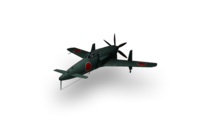Kyushu J7W1 Shinden
J7W1
| 2540000 Cena |
| 400 Odolnost |
| 5015 kgHmotnost |
| 507.1 Poškození |
| 1547.4 Rychlost |
| 720 km/hMax. rychlost v min. výšce |
| 720 km/hMax. rychlost v ideální výšce |
| 1400 mOptimální výška |
| 800 km/hMaximální střemhlavá rychlost |
| 118.4 m/sStoupavost |
| 120 km/hRychlost přetažení |
| 387 km/hOptimální rychlost letu |
| 85.4 Ovladatelnost |
| 10.8 sČas otočení o 360 stupňů |
| 100 °/sMíra náklonu |
| 1244.8 Obratnost |


Motor
| Úroveň | Motor | Výkon motoru, hp / Tah | Typ | Hmotnost, kg | Cena, |
|---|---|---|---|---|---|
| IX | NAME_MODULE_MK10B_SPEC_TOP_J7W1_1 | 3100 | vzduchem chlazený | 1520 | 179000 |
| IX | MK9F | 2500 | vzduchem chlazený | 1240 | 162000 |
| IX | MK10B | 3100 | vzduchem chlazený | 1520 | 179000 |

Drak letounu
| Úroveň | Drak letounu | Odolnost | Hmotnost, kg | Cena, |
|---|---|---|---|---|
| VIII | J7W1 | 400 | 3575 | 140000 |

Zbraň v trupu
| Úroveň | Kulomet | Ráže | Úsťová rychlost, m/s | Poškození | Rychlost střelby, výstřelů/min | Hmotnost, kg | Cena, |
|---|---|---|---|---|---|---|---|
| VII | 20 mm Type 99-2 Model 5 (T) | 20 | 1600 | 110 | 400 | 90 | 60900 |
| IX | 30 mm Type 5 (T) | 30 | 1040 | 220 | 170 | 120 | 80500 |
| IX | WEAPON_NAME_G30MM-TYPE5-F_SPEC_TOP_J7W1_1 | 30 | 1040 | 220 | 170 | 120 | 80500 |

Zbraň v podvěsu
| Úroveň | Pumy | Rozsah poškození, m | Poškození | Hmotnost, kg | Cena, |
|---|---|---|---|---|---|
| VI | 250kg | 75 | 4400 | 250 | 1200 |

Compatible Equipment
Compatible Consumables
Historical Info
The idea of a canard-based design originated with Lieutenant Commander Masayoshi Tsuruno, of the technical staff of the IJN in early 1943. Tsuruno believed the design could easily be retrofitted with a turbojet, when suitable engines became available. His ideas were worked out by the First Naval Air Technical Arsenal (Dai-Ichi Kaigun Koku Gijitsusho), which designed three gliders designated Yokosuka MXY6, featuring canards. These were built by Chigasaki Seizo K. K. and one was later fitted with a 22 hp Semi 11 (Ha-90) 4-cylinder air-cooled engine.
The feasibility of the canard design was proven by both the powered and unpowered versions of the MXY6 by the end of 1943, and the Navy were so impressed by the flight testing, they instructed the Kyushu Aircraft Company to design a canard interceptor around Tsuruno's concept. Kyushu was chosen because both its design team and production facilities were relatively unburdened, and Tsuruno was chosen to lead a team from the First Naval Air Technical Arsenal to aid Kyushu's design works.
The construction of the first two prototypes started in earnest by June 1944, stress calculations were finished by January 1945, and the first prototype was completed in April 1945. The 2,130 hp Mitsubishi MK9D (Ha-43) radial engine and its supercharger were installed behind the cockpit and drove a six-bladed propeller via an extension shaft. Engine cooling was to be provided by long, narrow, obliquely mounted intakes on the side of the fuselage. It was this configuration that caused cooling problems while running the engine while it was still on the ground. This, together with the unavailability of some equipment parts postponed the first flight of the Shinden.
Even before the first prototype took to the air the Navy had already ordered the J7W1 into production, with quotas of 30 Shinden a month given to Kyushu's Zasshonokuma factory and 120 from Nakajima's Handa plant. It was estimated some 1,086 Shinden could be produced between April 1946 and March 1947.
On 3 August 1945, the prototype first took off, with Tsuruno at the controls, from Itazuke Air Base.[4][10] Two more short flights were made, a total of 45 minutes airborne, by war's end. Flights were successful, but showed a marked torque pull to starboard (due to the powerful engine), some flutter of the propeller blades, and vibration in the extended drive shaft.
The production of J7W was canceled due to the end of World War II. The type never saw combat.
| Fighters | IINakajima A4N • IIKawasaki Ki-10 • IIKawasaki Ki-5 • IINakajima Ki-8 • IIIMitsubishi A5M • IIIMitsubishi Ki-18 • IIINakajima Ki-27 • IIIMitsubishi Ki-33 • IVMitsubishi A6M1 Zero • IVNakajima Ki-43-I Hayabusa • VMitsubishi A6M2 Zero • VMitsubishi A6M3 (experimental) • VNakajima Ki-43-II Hayabusa • VIMitsubishi A6M5 Zero • VIKawasaki Ki-61 Hien • VIKawasaki Ki-88 • VIIMitsubishi A7M Reppu • VIINakajima Ki-84 Hayate • VIIIMitsubishi J8M Shusui • VIIITachikawa Ki-94-II • IXTachikawa Ki-162-I • XTachikawa Ki-162-III |
| Heavy Fighters | VKawasaki Ki-45 Toryu • VIKawasaki Ki-102 • VIIRikugun Ki-93 • VIITachikawa Ki-94-I |
| Attack Aircraft |
